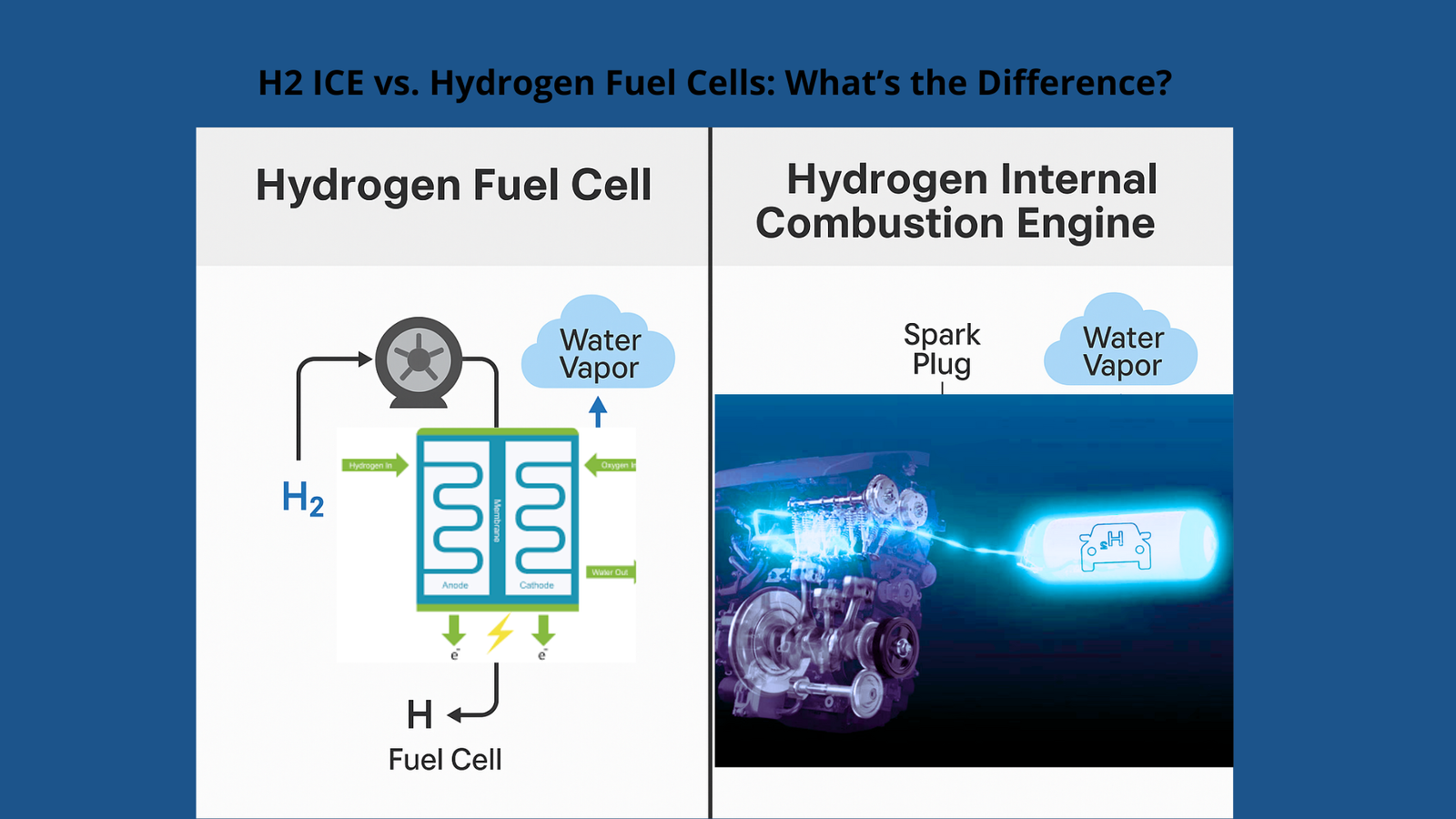<figure class="wp-block-post-featured-image"><img width="1920" height="1080" src="https://imcarenthusiast.com/wp-content/uploads/2025/05/h2-ice-vs-hydrogen-fuel-cells-whats-the-difference-1.png" class="attachment-post-thumbnail size-post-thumbnail wp-post-image" alt="H2 ICE vs. Hydrogen Fuel Cells: What’s the Difference?" title="H2 ICE vs. Hydrogen Fuel Cells: What’s the Difference?" style="object-fit:cover;" data-wp-pid="2342" data-hero-candidate="" /></figure><p>As the transportation industry moves toward cleaner alternatives, two hydrogen-based technologies have gained attention: hydrogen internal combustion engines (H2 ICEs) and hydrogen fuel cells. Both aim to reduce emissions and dependence on fossil fuels—but they work in fundamentally different ways.</p><h3 class="wp-block-heading">What Is an Hydrogen Fuel Cell?</h3><p>Hydrogen fuel cells generate electricity through a chemical reaction between hydrogen and oxygen. This electricity powers electric motors, much like those in battery-electric vehicles (BEVs). The only byproducts are water vapor and heat.</p><p>More info: <a href="https://www.volvogroup.com/en/sustainable-transportation/sustainable-solutions/hydrogen-fuel-cells.html">Volvo Group – Hydrogen Fuel Cells</a></p><h3 class="wp-block-heading">How Does a Hydrogen Internal Combustion Engine Work?</h3><p>H2 ICEs, on the other hand, burn hydrogen in a traditional internal combustion engine, much like gasoline or diesel. Hydrogen is injected into the combustion chamber, mixed with air, and ignited with a spark plug, driving the pistons.</p><p>More details: <a href="https://en.wikipedia.org/wiki/Hydrogen_internal_combustion_engine_vehicle">Wikipedia – Hydrogen Internal Combustion Engine Vehicle</a></p><h3 class="wp-block-heading">Key Differences Between the Two</h3><figure class="wp-block-table"><table class="has-fixed-layout"><thead><tr><th>Feature</th><th>Hydrogen Fuel Cells</th><th>Hydrogen Internal Combustion Engines</th></tr></thead><tbody><tr><td><strong>Power Source</strong></td><td>Electrochemical reaction</td><td>Combustion (spark ignition)</td></tr><tr><td><strong>Efficiency</strong></td><td>Higher (~60%)</td><td>Lower (~40%)</td></tr><tr><td><strong>Maintenance</strong></td><td>Fewer moving parts, less maintenance</td><td>Similar to traditional ICEs</td></tr><tr><td><strong>Refueling Time</strong></td><td>Quick (~5 min)</td><td>Quick (~5 min)</td></tr><tr><td><strong>Emissions</strong></td><td>Pure water vapor</td><td>Water vapor + possible NOx</td></tr><tr><td><strong>Noise Level</strong></td><td>Very quiet</td><td>Louder (similar to petrol engines)</td></tr><tr><td><strong>Infrastructure Compatibility</strong></td><td>Requires new electric drivetrain</td><td>Compatible with existing engine systems</td></tr></tbody></table></figure><h3 class="wp-block-heading">Which One is Better?</h3><p>There’s no clear winner. It depends on the use case:</p><ul class="wp-block-list"><li><strong>Fuel cells</strong> are ideal for light-duty passenger cars and city buses.</li>

<li><strong>H2 ICEs</strong> may be more suitable for heavy-duty, off-road, and industrial applications, where engine robustness and mechanical familiarity matter.</li></ul><p>Read more from industry leaders:</p><ul class="wp-block-list"><li><a href="https://www.cummins.com/engines/hydrogen">Cummins on Hydrogen Engines</a></li>

<li><a href="https://blogs.sw.siemens.com/simcenter/hydrogen-fueled-internal-combustion-engine/">Siemens on H2 ICE Development</a></li>

<li><a href="https://www.jcb.com/en-us/campaigns/hydrogen">JCB&#8217;s H2 ICE in Construction</a></li></ul><h3 class="wp-block-heading">Conclusion</h3><p>Both hydrogen fuel cells and H2 ICEs are crucial to achieving a zero-emission future. Understanding their differences helps us apply the right solution to the right problem. While fuel cells shine in quiet, efficient transport, H2 ICEs offer a more seamless shift from traditional engines for specific sectors.</p><p>Stay tuned for Blog Post #3: “Challenges Facing Hydrogen Vehicles: Storage, Infrastructure, and Cost.”</p><hr class="wp-block-separator has-alpha-channel-opacity"/><p></p><p></p> 
 <div class="abh_box abh_box_down abh_box_minimal"><ul class="abh_tabs"> <li class="abh_about abh_active"><a href="#abh_about">About</a></li> <li class="abh_posts"><a href="#abh_posts">Latest Posts</a></li></ul><div class="abh_tab_content"><section class="vcard author abh_about_tab abh_tab" itemscope itemprop="author" itemtype="https://schema.org/Person" style="display:block"><div class="abh_image" itemscope itemtype="https://schema.org/ImageObject"><a href = "http://www.imcarenthusiast.com" class="url" target = "_blank" title = "Edge" rel="nofollow" > <img src="https://imcarenthusiast.com/wp-content/uploads/gravatar/auto-garage-2.png" class="photo" width="250" alt="Edge" /></a > </div><div class="abh_social"> <a itemprop="sameAs" href="https://facebook.com/facebook.com/imcarenthusiast" title="Facebook" class="abh_facebook" target="_blank" rel="nofollow"></a></div><div class="abh_text"><div class="abh_name fn name" itemprop="name" ><a href="http://www.imcarenthusiast.com" class="url" target="_blank" rel="nofollow">Edge</a></div><div class="abh_job" ><span class="title" >Online Editor</span> at <span class="org" ><a href="http://imcarenthusiast.com" target="_blank">imcarenthusiast.com</a></span></div><div class="description note abh_description" itemprop="description" >Mechanic Gear Head, part-time Motorsport Fan, Automotive Journalist wannabe. The "four wheels" universe has been in him since forever; since then, it's been lap after lap.</div></div> </section><section class="abh_posts_tab abh_tab" ><div class="abh_image"><a href="http://www.imcarenthusiast.com" class="url" target="_blank" title="Edge" rel="nofollow"><img src="https://imcarenthusiast.com/wp-content/uploads/gravatar/auto-garage-2.png" class="photo" width="250" alt="Edge" /></a></div><div class="abh_social"> <ahref="https://facebook.com/facebook.com/imcarenthusiast" title="Facebook" class="abh_facebook" target="_blank" rel="nofollow"></a></div><div class="abh_text"><div class="abh_name" >Latest posts by Edge <span class="abh_allposts">(<a href="https://imcarenthusiast.com/author/imcarenthusist/">see all</a>)</span></div><div class="abh_description note" ><ul>				<li>					<a href="https://imcarenthusiast.com/gp-de-singapura-2025/">George Russell vence GP de Singapura 2025 e McLaren conquista título de Construtores da F1</a><span> - 05/10/2025</span>				</li>				<li>					<a href="https://imcarenthusiast.com/ford-recall-2024/">Ford estabelece recorde de recalls: 1,9 milhões de veículos afetados e multa de US$ 1,65 mil milhões</a><span> - 02/10/2025</span>				</li>				<li>					<a href="https://imcarenthusiast.com/redesign-do-nissan-sentra-para-2026-surpreende-com-grandes-alteracoes/">Redesign do Nissan Sentra para 2026 surpreende com grandes alterações</a><span> - 24/09/2025</span>				</li></ul></div></div> </section></div> </div>
H2 ICE vs. Hydrogen Fuel Cells: What’s the Difference?






